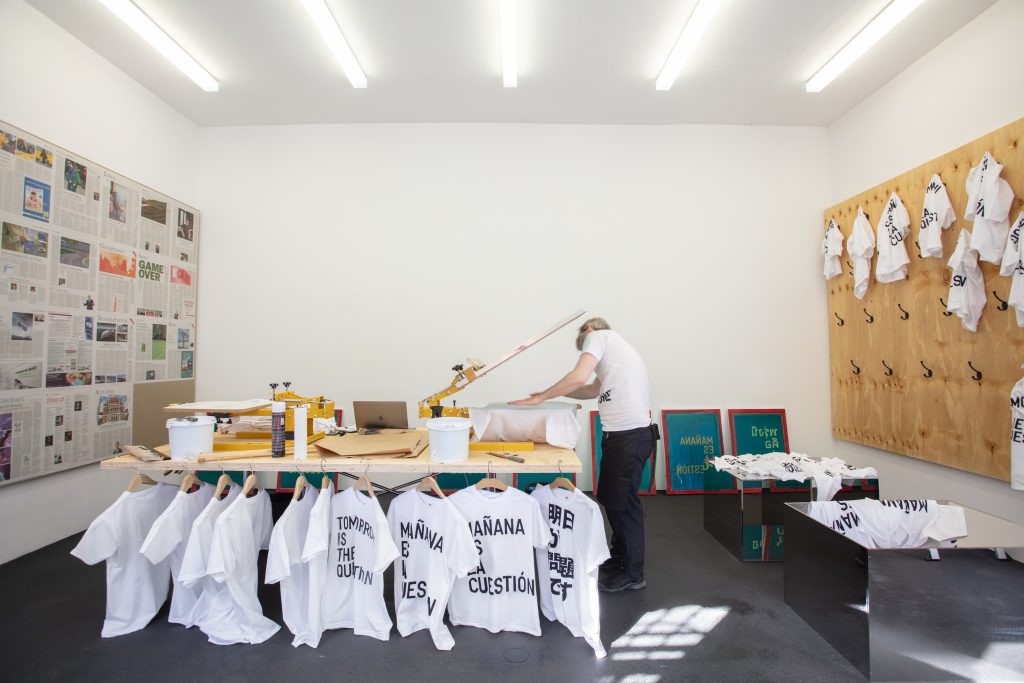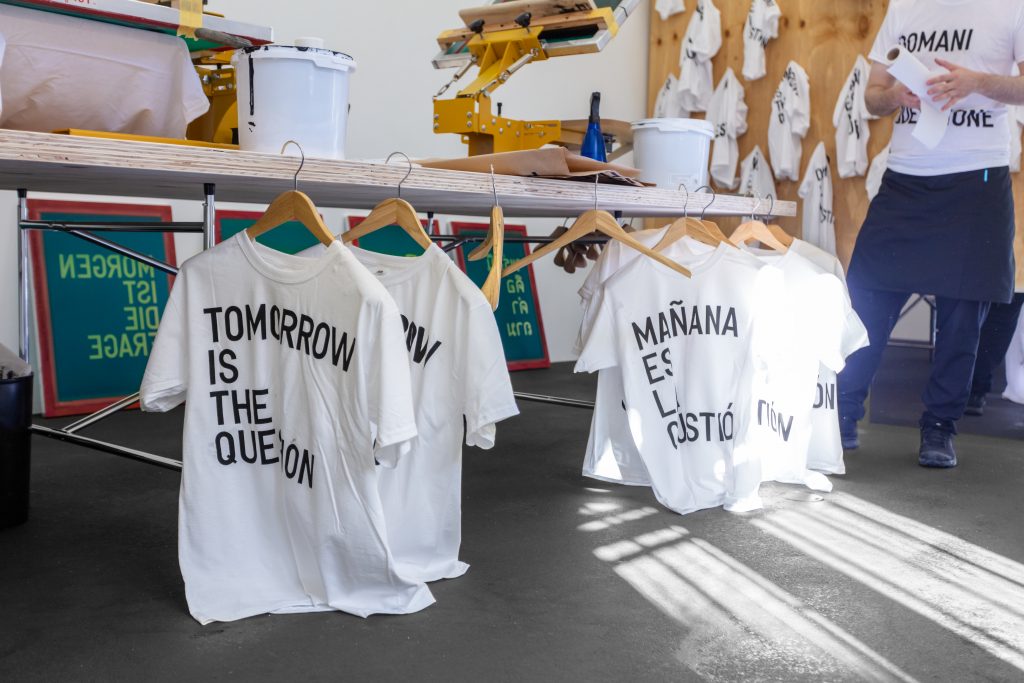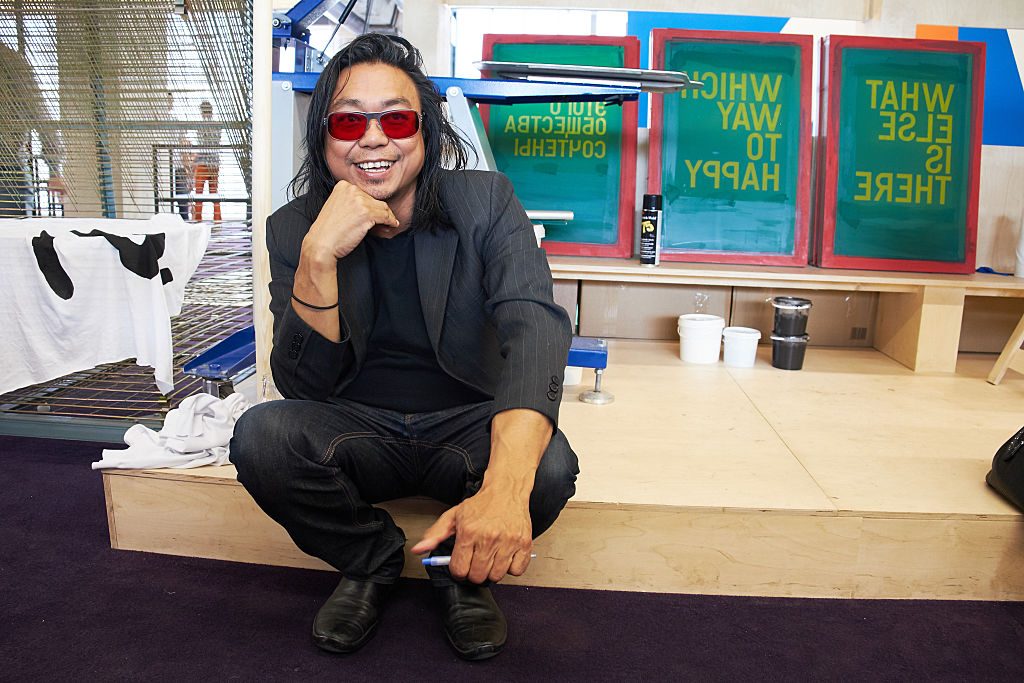Art Fairs
Can Relational Aesthetics Survive the Social Distancing Era? Artist Rirkrit Tiravanija Is Giving It an Innovative Try in Berlin
The artist's latest project is part of Art Basel's fall online viewing rooms.

The artist's latest project is part of Art Basel's fall online viewing rooms.

Kate Brown

In a year of almost entirely screen-based art viewing, I had the rare pleasure of stepping my two feet inside gallery neugerriemschneider’s “booth” at its Art Basel online viewing room. If that sounds unusual, it’s because the gallery has taken a unique approach to the online-only edition of the fair this fall.
The artist Rirkrit Tiravanija has turned the Berlin gallery into a live-streamed performance-piece-cum-sculpture, inside which the entire staff is working shifts. The project, titled Untitled 2020 (morgen ist die frage), runs until Sunday as a part of Art Basel’s “OVR:2020,” one of the fair’s two planned viewing rooms this fall. Just 100 galleries were selected with proposals that focused on artworks conceived in 2020.
Tiravanija takes the year’s events as his material. Gallery staff will write questions from visitors, posed via Art Basel’s new live-chat, onto a large newsprint painting, consisting of every page from the Frankurter Allegemeine Zeitung newspaper starting the day after Germany’s lockdown.
The smell of heavy acrylic wafts out into the gallery’s courtyard from a small room where Tim Neuger and two employees are donning black aprons, silkscreening t-shirts, and draping them over a pair of sculptures and a wall piece. Everything in the room is part of the work for the next three days, 24 hours a day, including me for the moment. Neuger, who founded and helms the gallery with Burkhard Riemschneider, is finishing his two-hour shift.

Untitled 2020 (morgen ist die frage) (2020). © Rirkrit Tiravanija. Courtesy the artist and neugerriemschneider, Berlin Photo by Marjorie Brunet Plaza.
“Art and life, and life and art—whenever Rirkrit creates a piece, everything gets sucked into it,” Neuger tells Artnet News. The title of one of the Argentina-born, Thai artist’s past exhibitions, “Tomorrow is the question,” has gained new traction in a year tossed up by uncertainty. Its German translation is currently hanging as a large white banner over the facade of Berghain, the legendary Berlin nightclub that has been shut down since March (though it is currently hosting a group show organized by collectors Christian and Karen Boros).
Tiravanija sees a silver lining in the mass online migration. “There is also the possibility for engagement and participation from viewers directly in the realization of the work itself,” he says. “I think with a lot of my work, the work isn’t complete without the interaction of the audience. But of course it’s referential in relationship to the time, the moment of its realization, to the situation and conditions surrounding us, and then to ask, or rather to think ‘tomorrow is the question.'”

Artist Rirkrit Tiravanija. Photo by Oleg Nikishin/Getty Images.
After hosting a few viewing rooms this year that received mixed reviews, Art Basel is hoping this more curated, thematically-focused iteration—with a fraction of the usual participants—might garner better engagement and sales. Likewise, galleries have been learning how to adapt to the new format. How do you draw someone into your viewing room? How do you entice them to stay and talk? The digital space does not adhere to the same rules of the fair floor.
“It’s very different to think about our booths digitally,” Neuger says, adding that no one really knows how art viewership is going to evolve. The gallery, which was founded in 1994 and represents artists including Elizabeth Peyton, Ai Weiwei, and Olafur Eliasson, usually enjoys prime real estate on the floor at Art Basel. “Usually, we plan our booth concepts a year in advance and prepare them to meet the quality level of our exhibitions. Of course, online does not work like that.”
One year, the gallery presented a sort of inversion of this current piece, where Tiravanija boarded up the entire Basel booth. The entire gallery stayed home in Berlin and turned their phones off.

Untitled 2020 (morgen ist die frage), (2020). © Rirkrit Tiravanija. Courtesy the artist and neugerriemschneider, Berlin Photo by Marjorie Brunet Plaza.
The 2020 shutdown has caused community-made works like Tiravanija’s—works that are completed by the presence and engagement of others—to all but disappear through the months of emailed jpegs. And transposing brick-and-mortar concepts into the digital sphere rarely brings lively results, as most of us have experienced this year. “When tactility of the work is not present, you have to think in a whole different way,” Neuger says.
Tiravanija’s time-based and live-streamed work-in-process installation is an experiment in this direction. It is sort of like a stage, and everyone has a part. Everything in the space is oriented toward the audience peering through a small webcam above the door. Standing in the room, everything is slightly off-center, catered to the small glass eye above. The central query for viewers is written on the table: “If tomorrow is the question, what is the question?” Tiravanija’s large canvas is primed and waiting for responses.
Untitled 2020 (morgen ist die frage), (2020) by Rirkrit Tiravanija is on view at neugerriemschneider’s viewing room at ART BASEL OVR:2020 until Saturday, September 26.